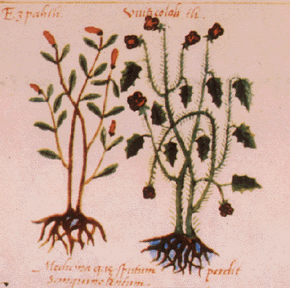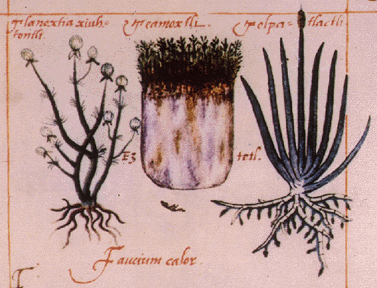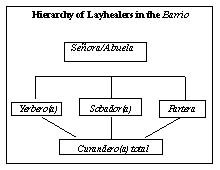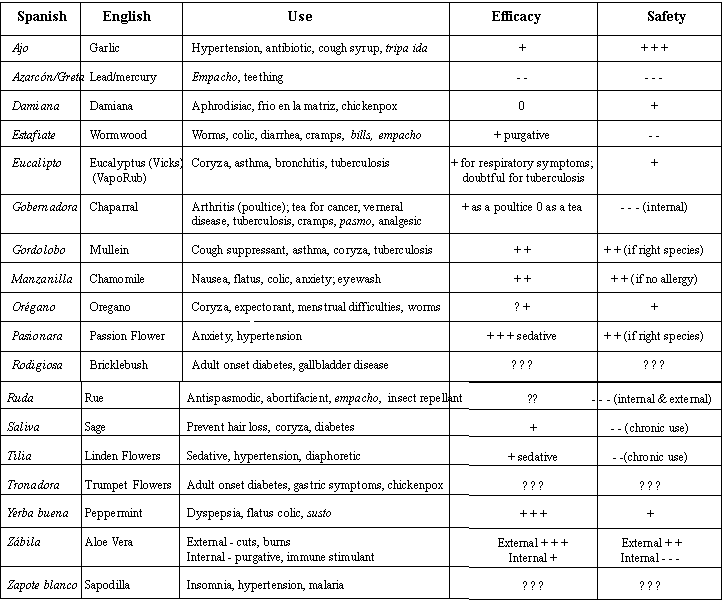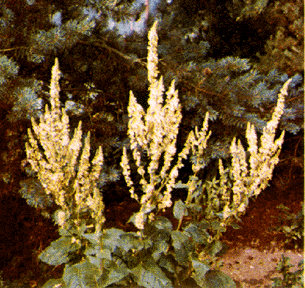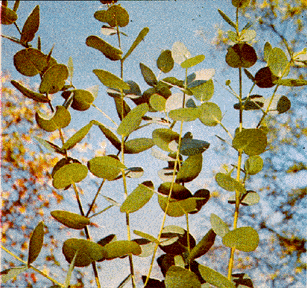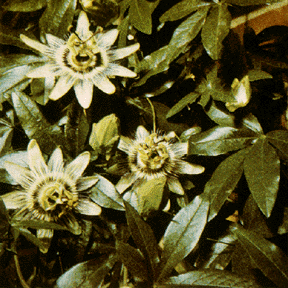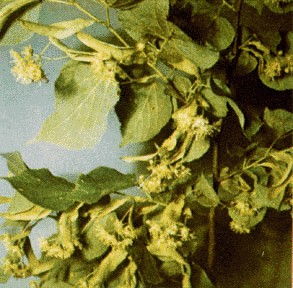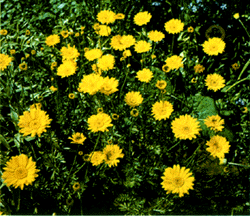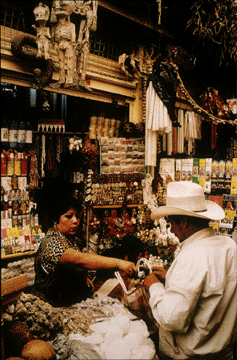8.
Folk Medicine in Hispanics
While stereotypical folk medicine is often
thought to be used by only poor and/or unacculturated people, the truth is
that all of us have used (or have had used on us) some form of folk
medicine in the guise of home remedies. People use folk remedies (or home
remedies) for several reasons: treatment of minor illnesses (for which
they would not consider consulting a doctor), the retention of a locus of
self-control, and if accessibility to medical care is limited. Treatment
may be given in one’s own home, one of a relative, or in certain cases,
it could be at a curandero’s (or lay healer’s) home.
Personal belief systems are integral to the type of folk medicine used.
During the process of growing up, individuals learn the concepts of
sickness and health along with religious faith from their families. Folk medicine (or lay medicine) is "the ordinary person’s
concept of health, illness, and healing; it is the treatment of disease
practiced traditionally among the common people stressing the use of herbs
and other natural substances" (Webster). It is felt that intrinsic
goodness and comfort come from these—they are accessible, economical,
and validated by one’s family and faith. While the medical profession
has tended to attribute any beneficial effects from folk remedies to the
power of the placebo, many of these remedies have been in existence for
thousands of years and, as such, may well have physical benefits. Concept of Disease Intrinsic to an understanding of why people choose folk medicine is an
understanding of how the ordinary person defines disease. The term
"disease" generally signifies any organic illness. All cultures
have systems for classifying diseases on the basis of etiology,
signs/symptoms and treatments. Many cultures, modern and ancient, have
felt that when one’s system is out of balance, one will become ill.
Physicians have often seen patients who, when they feel well, believe they
are well, leading to a denial of or delay in diagnosis and treatment of
early stages of diseases such as diabetes mellitus, hypertension, and
tuberculosis. The concept of disease prevention is completely alien in
this belief context.
|
People tend to look for reasons why they become ill. From the ancient Greeks came theconcept that disease occurs when there is an imbalance of the four humors, or, what has survived into Hispanic folk medicine today, that disease is caused by an imbalance between hot and cold principles. For health maintenance, avoidance of exposure to extreme temperatures is important. Vasoconstriction and a low metabolic rate signify one |
|
has
a "cold" disease while "hot" conditions are
characterized by vasodilation and a high metabolic rate. Examples of
"hot" diseases or states are pregnancy, hypertension,
diabetes, acid indigestion, susto, ojo and bìlis. Some
"cold" disease examples are menstrual cramps, frio de la
matriz, coryza, pneumonia, empacho, and colic. Most people do not think about hot and cold
principles unless they have been stressed by illness or are in another
vulnerable state. The goal of treatment is to restore harmony and balance.
Thus, "hot" diseases are treated with "cold" remedies,
and "cold" diseases are treated with "hot"
remedies.The Meso-American Indians had a very sophisticated system of
health, disease, and treatment. They established the first medical schools
in Mexico fifty years before Jamestown was settled, and used a
pharmacopeia of over 5,000 well-studied and efficacious Indian herbal
medications that have been categorized in the Badiano Codix (1552). In
that native system of medicine, a strong connection between religion and
health existed.
|
|
|
|
Utilization of Lay Healers Among Hispanics Studies have shown that 90% of folk medicine adherents do not use the services of a curandero, or lay healer, but obtain their remedies from a hierarchy of lay healers. Neighbors and relatives are valuable sources of information. Those whose conditions cannot be treated by a senora/abuela are usually referred to a yerbero (herbalist), sobador (massage therapist), or partera (mid-wife, whoalso treats problems with young children) If these (specialists) cannot handle the problem then the patient is referred to a curandero total (the lay healer who may use multiple modalities). These people are highly respected in the local community and they may come from either a family with a tradition of curanderisimo or receive the gift of healing (el dón) later in life. |
|
Two of the most highly revered lay healers in South Texas and Mexico, Niño Fidencio and Don Pedro Jaramillo, lived in the late 1800’s and early 1900’s; they both have active followers who venerate them at shrines today. There is no direct remuneration for services rendered by the curanderos, but most of them do accept gifts. While the curandero has clear expertise in folk illnesses, 80% of the folk remedies are for medical problems. Most curanderos know what they cannot handle and will refer severe health problems to the medical profession, including their own.
Hypertension
Hypertension is defined as a hot illness. In 60% of the cases the etiology is thought to be due to corajes (anger) or susto (fear); the remaining 40% are felt to be due to "thick blood". Cool remedies such as bananas and lemon juice are popular as well as teas of passion flowers (pasionara), linden (tilia), or zapote blanco.
Diabetes Mellitus
Diabetes mellitus is also a hot illness. While the curanderos will no doubt encourage consultation with a physician, various remedies may also be used. Nopal (or cactus), aloe vera juice, or bitter gourd can be taken. In some areas in Texas and Mexico treatment is started with maturique root infusion for approximately one week if the person is extremely hyperglycemic. Subsequently for maintenance therapy, trumpet flower-herb or root infusion (tronadora), brickle bush (prodigiosa) tea, or sage tea (salvia) are used. The proven safety and efficacy of maturique, trumpet flower, or bricklebush preparations are not known. Aloe vera juice is reasonably safe but aloe vera latex is a powerful purgative. Sage tea taken chronically can lower the seizure threshold and has been reported to cause mental and physical deterioration because it contains thujones and tannins.
Other medical illnesses for which folk treatment by herbalists or curanderos is prescribed include:
• Upper respiratory infection
• Asthma
• Osteoarthritis/rheumatism
|
Folk Medicine-Treatments
- Oregano de la sierra tea (oregano-antitussive, relief of sore |
|
Folk Medicine-Treatments
- Romero (rosemary) |
v Treatment of Folk Illnessess
Curanderos are the clearly acknowledged experts in diagnosing and treating folk illness in the barrio. Folk illness is "a syndrome in which members of a particular group claim to suffer and for which their culture provides a etiology, diagnosis, preventive measure and regimen of healing" (Rubel). Folk illnesses have a high degree of psychological and/or religious overtones. Family involvement is an intrinsic part of the healing process, and people improve because of their religion, personal faith in the remedies, and familial commitment.
Conclusion
Since folk beliefs are wide-spread to varying degrees, the effective health care provider would do well to heed the following recommendations:
• Understand (and be sensitive) to the role folk medicine may play in
patients one encounters;• Practice delivering messages of tolerance and respect–"the art of
medicine,"• During the interview, ask "What do you think caused your illness?," and
"We all have favorite remedies that we use when we are sick. What have
you done to treat this condition?";• When appropriate, and not contraindicated, incorporate some benign folk
medicine remedies into one’s advice to the patient to improve the
compliance and trust;
•
As an example, when encouraging liquid intake for
colds and flu, consider
suggesting te de manzanilla (chamomile tea) with
other electrolyte
replacement as part of the therapeutic regimen.
|
Folk Remedies Everyone should know |
|
|
Illustrations: Plants and Herbs Commonly Used as Folk Remedies
|
|
|
|
|
|
|
|
Curandera Preparing for a Barrida
|
|
|
Contributed by Nancy Neff, MD. Assistant Professor, Department of Community Medicine, Baylor College of Medicine.
http://www.rice.edu

